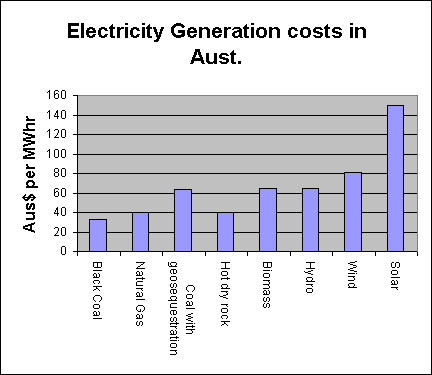There seems to be nowhere on the Internet that hydro-power generation figures
are available for the whole of Australia.
(I have made inquiries, Feb. 2009, but do not yet have an answer.)
Wikipedia has a page listing
hydro power plants in Australia.
| Wind and water
|
|---|
| Hydro has been Australia's biggest sustainable energy
type; this is changing.
Below is a rough comparison from the figures on the left.
| | Generated power (GWh/yr)
|
|---|
| Hydro (Snowy+HydroTas) | 14 800
| | Wind | 5 000
| | While Snowy-Hydro and Hydro Tas. are the biggest hydro
companies in Australia, there are many other hydro power stations scattered
about the eastern states.
Hydro power has decreased during recent years because of decreasing rainfall,
wind power is increasing as wind farms continue to be built.
| | Installed power (MW)
|
|---|
| Hydro | 8000
| | Wind | 1800
| |
The installed power data was extracted from the
Dept. Environment, Water,
Heritage and the Arts site, 2009/02/20, and applies to all recorded
installations in Australia.
This table was created Nov. 2008 and modified March 2009.
|
Wikipedia states that the Snowy Mountains Hydro-Electric Authority
"generates on average 4500 gigawatt hours of renewable energy each year".
The Snowy-Hydro site gives the
same figure.
Hydro Tasmania runs all hydro power
stations in Tasmania and states its long-term average power
output as 1180MW (=10 300GWh/yr).
As a comparison, South Australia, the top wind power state in Australia,
was producing around 210GWh per month (=2500GWh/yr) as of May 2008
(from the Electricity Supply Industry Planning Council of SA, Annual
Planning Report, 2008, p64.)
The remainder of Australia was producing almost as much wind energy as SA.
AGL owns
ten hydroelectric generating schemes comprising 16 power stations in
Victoria and NSW.
AGL is constructing a new $230 million, 140MW underground hydropower station
near Bogong village and beside Lake Guy.
The project does not involve building a dam, but does include a new 6.5km
tunnel.
Some information is on one of the
Bogong village
pages.
Wind and solar power are subject to major variations in availability.
Hydropower is ideally suited for 'filling in the gaps' in the electrical
supply because it can be quickly started and stopped as needed.
Denmark obtains about 20% of its power from wind (World Wind Energy Report,
2008) and buys hydro-power from nearby Norway as required to fill in any
short-fall in power supply when the wind is insufficient.
Not only can hydropower be fed into the electricity grid when there is a
shortage of supply and the wholesale price is high, but energy can be
stored as potential hydropower when there is an excess of energy and the
wholesale price is low.
Instead of generating power from falling water, power can be used to lift
water from a low-level storage to a high-level storage.
This is a form of Price Responsive Load.
The reduced run-off into hydropower catchments in recent years is a major
problem, but it could be overcome by developing pumped recycling of the
limited water in the system (see
Pumped-storage hydroelectricity in Wikipedia).
Tumut 3 Power Station in the Snowy Mountain Scheme of NSW, for example, is
set up for pumped-storage.
In generating mode water can flow from the upstream storage, behind
Talbingo Dam, through anything up to six turbines into the downstream
storage, behind Journama Dam.
At times when electricity is plentiful and cheap, two of the Tumut 3 turbines
can be used as pumps to lift water from the Journama pondage up into the
Talbingo pondage.
In effect, electricity is stored in the form of the potential energy of the
water in the high storage.
This system can be, I believe, about 80% efficient.
I know of no new development of pumped-storage hydro in Australia aimed
specifically at balancing the grid since wind power has become a major
component of our power supply; apparently gas-fired power stations are
a cheaper option in the short-term.
In contrast, the Dutch are so committed to wind that they are seriously
considering building an "energy island" in the north sea.
(The Netherlands, being very flat, does not have hydropower or potential
hydropower in the 'normal' sense.)
The idea involves building a circular dam in water about 20m deep, creating
a controlled storage area several kilometres in diameter.
The water will be pumped out of the storage into the sea when wind farms have
put plentiful and cheap energy into the grid, it will be allowed to flow
back in through turbines when the electricity in the grid is in short
supply and its price is high.
See Times Online.
This could be done in places around the Australian coast, but I suspect
developing pumped-storage at existing hydropower stations would be a cheaper
option.
|




